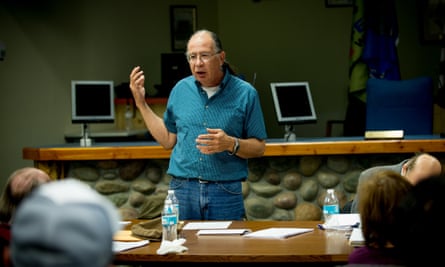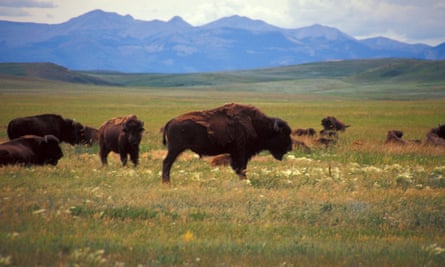It’s Tuesday evening on the Blackfeet Indian reservation, which means time for a shared meal and a strategy session on how to overturn the government.
Tribal councilman Joe McKay and a group of like-minded reformers gather at tribal headquarters – over home-cooked roasted pork, chicken, potatoes, salad and bread – to discuss how to convince their fellow Blackfeet Nation members to vote for a new constitution this month.
What begins each week as a friendly potluck at Blackfeet tribal headquarters has been for nearly three years the situation room in a battle to create a new constitution and bring it to a public vote. They’re in the homestretch, hoping on 27 June to dispose of a tribal council system they say has left the tribe mired in poverty and infighting through corruption and a lack of checks and balances.
“Even though resource-wise, we may be one of the richest tribes in the nation, we are in one of the poorest places in America,” McKay said. “We can trace that back to our system and the failures of our system toward its people.”
This is not a uniquely Montana revolution. The Blackfeet Nation is just one of many tribes engaged in a radical reform campaign across Indian country that has gone largely unnoticed.

The Standing Rock protests in North Dakota last year became a symbol of the struggle for Native American empowerment, but this quieter, less boisterous push to strengthen tribal governments and give them firmer footing as sovereign nations has been gaining traction for years.
Constitutional reform, according to sociologist Stephen Cornell, co-director of the Harvard Project on American Indian Economic Development, “is an attempt by many of these nations to equip themselves with more effective governing institutions – institutions that can do a better job of exercising the self-governing powers that tribes possess”. With stronger governmental systems, tribes might be better able to deal with the realities of modern governance, such as negotiating oil and gas deals with huge conglomerates.
McKay, an attorney who grew up here and saw his own father fight for constitutional reform five decades ago, ran for tribal council in 2014 with the stated goal of upending the system and replacing it with a three-branch government that is ultimately accountable to the people.
“There’s a single word that describes why we are sitting in this room today: power. The use and abuse of power. The council has absolute power. So if you muster the majority of the council, you control everything,” McKay said. “It doesn’t matter how unethical, illegal, unjust it might be. As long as you have the votes and the power, you control everything. In that setting, societies don’t flourish. They go backwards.”

Perhaps the best way to understand the Blackfeet tribe’s predicament is through the lens of Glacier national park, a jewel in the US parks system. Last year, nearly 3 million people visited the park and its untamed wilderness, a record number of tourists bringing cash and vibrancy to north-west Montana. The Blackfeet reservation borders the park to the east, but only a tiny fraction of those tourists spent any time or money there; tribal members call the reservation’s busy casino the “cash recycling center”, a place that draws mostly locals instead of tourists.
Browning and the surrounding reservation are not the Montana of fancy log homes, craft beers and western-style resorts, but a windswept patch of dilapidated reservation housing, poverty and the state’s highest unemployment rate. Glacier County, which contains the Blackfeet reservation, ranks 54 out of Montana’s 56 counties for per capita income. The surrounding scenery is stunning, but the tribe has never been able to draw what it should from its economic potential. Critics of the tribal council system of governance say it has been riddled with corruption for years and often put the interests of council members and their families ahead of the tribe.
Five years ago, the tribe was unable to pay its bills or even make payroll. McKay and reformists argue that the governing document – a holdover handed down by the federal government decades ago – allows only for a single branch of government that controls the judiciary and everything else.
“It’s not a system that has allowed our people to grow over time,” McKay said. “It’s a system that has facilitated the waste of hundreds of millions of dollars of the tribe’s own money.”
McKay and others point to what they call “the meltdown”, which began in 2012 with a council fight over spending and ended with the creation of a rival council, dozens of tribal employees fired and a long drama involving threats, intimidation and allegations of misspent government money.

On the Blackfeet reservation, opposition to the constitutional reform movement has come mainly from a whisper campaign that the new document will open Blackfeet tribal membership for non-enrolled members. The constitution changes the language, calling Blackfeet “citizens” rather than tribal “members”, but changes nothing about who is or is not Blackfeet.
Sheri Welch, a Blackfeet voter who has been involved in the reform effort, said that what is most important is the new document introduces checks on power with an independent judiciary and the power for voters to recall tribal council members.
“I guess the biggest thing this constitution can give is the ability to change. There are so many things I don’t like about it,” Welch said, but, “there were some really unethical things that were happening under the current constitution, so anything is better than what we got.”
But critics of the new draft constitution have a more cynical view of government generally.
“If our old constitution didn’t work because our council members wouldn’t uphold it, what makes you think the new constitution will work,” Blackfeet voter Verena Rattler argued in a letter to local newspapers this year. “It will still be manipulated and it won’t be upheld. It isn’t the document that isn’t working, it is the council members that you vote in that doesn’t make it work.”
Voting, which allows off-reservation Blackfeet – nearly half of the tribe’s membership – to vote, began in May by mail and ends 27 June with physical polls open for a day.
For some, this is a fight for the very survival of the Blackfeet Nation. When tribes were given boilerplate constitutions in the 1930s, there was some expectation that eventually they would eventually be folded into local governments. Instead, in 1975, tribes were given the right to self-determination.
“This system, I really believe, was set up to fail. They knew it was going to fail,” said Darrell Norman, a Blackfeet artist who helped write the proposed constitution. “It’s going to implode.”
Around Browning, the main city on the reservation, many believe the draft constitution will pass. Then, of course, the real work of implementing an entirely new system of government will begin.

Comments (…)
Sign in or create your Guardian account to join the discussion